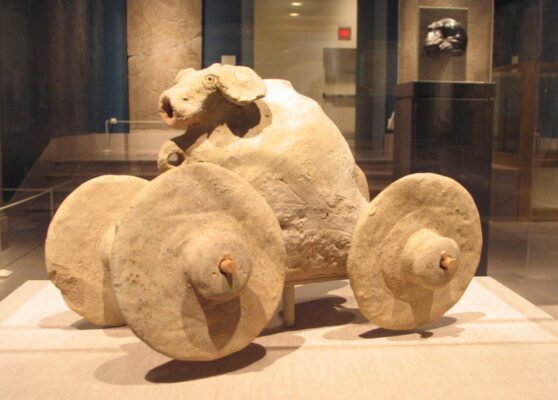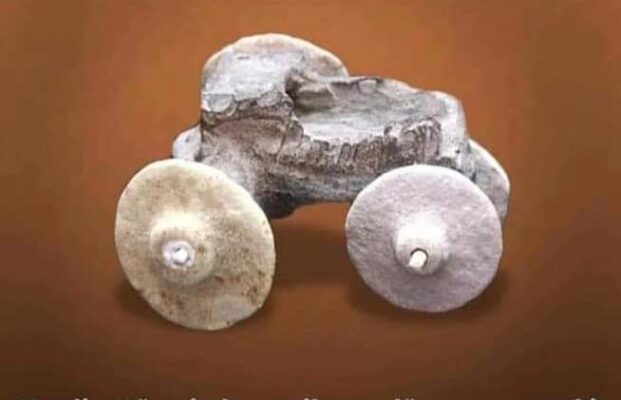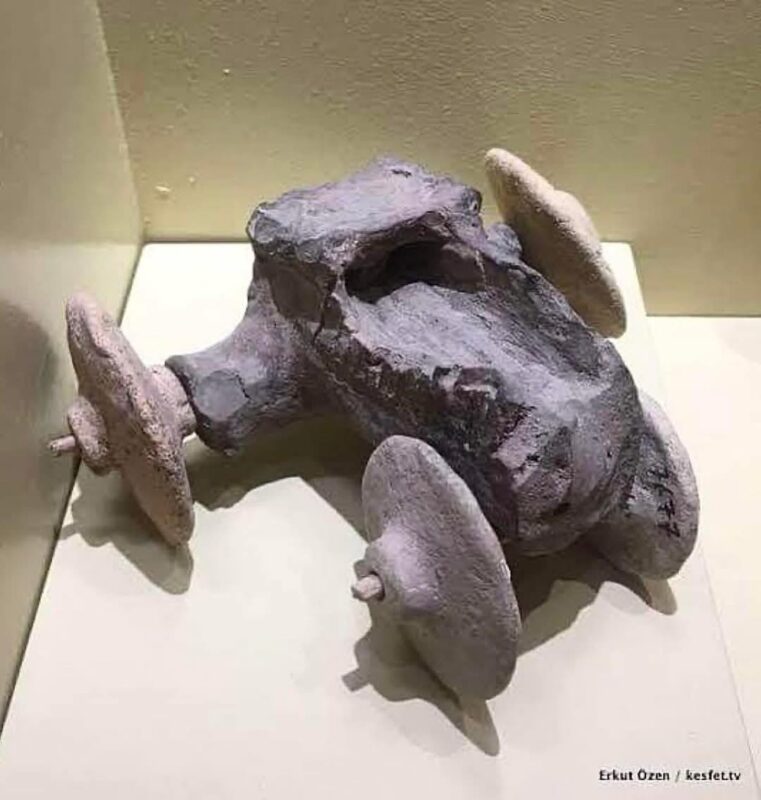The world’s oldest surviving toy, dating back to the Chalcolithic Period (5500–3000 BC), offers a captivating insight into the creativity and daily lives of ancient civilizations. This remarkable artifact is preserved in the Mardin Museum in Türkiye, a region steeped in history and culture at the heart of Mesopotamia—often referred to as the cradle of civilization. Follow archeology.dulichvn.net to discover many hidden mysteries that have yet to be discovered.

1. A Journey Back in Time
1.1 The Chalcolithic Period: A Time of Groundbreaking Innovation
The Chalcolithic Period, spanning approximately 5500–3000 BC, was a transformative era in human history. It bridged the gap between the Stone Age and the Bronze Age, combining the practicality of stone tools with the revolutionary introduction of metalworking. Societies during this time demonstrated remarkable advancements in technology, agriculture, and craftsmanship, laying the foundation for more complex civilizations to emerge.
Toys from this period serve as a testament to the creativity and ingenuity of early societies. Far from being mere trinkets, these artifacts reveal the development of artistic expression and the ability to craft intricate objects. They showcase how even in prehistoric times, people prioritized play, imagination, and the nurturing of young minds—an enduring human trait that connects us to our ancient ancestors.
1.2 Discovery of the Oldest Toy: A Portal to Ancient Childhood
The discovery of the world’s oldest toy in Türkiye is a milestone in archaeology, offering a rare glimpse into the daily lives of children who lived thousands of years ago. Unearthed during meticulous excavations in the historically rich region of Mesopotamia, this artifact underscores the universal nature of childhood and play.
The toy, believed to be crafted with care by ancient artisans, might have been a cherished possession for a child. Its preservation is a stroke of archaeological fortune, allowing us to bridge millennia and understand that the joy and creativity of play have always been a part of the human experience. This discovery not only enriches our understanding of ancient cultures but also humanizes them, showing that their desires and expressions were not so different from our own.
1.3 Symbolism and Purpose: Toys as Cultural Mirrors
In ancient societies, toys were much more than objects of amusement—they were imbued with deep cultural and educational significance. Often made to resemble animals, tools, or household items, these miniature creations reflected the world children would one day inherit.
Toys served as tools for socialization, teaching young ones essential skills, and introducing them to societal roles. They were also expressions of cultural identity, symbolizing values such as creativity, resourcefulness, and community. In some cases, toys even carried spiritual or ritualistic significance, acting as talismans or representations of deities.
The oldest surviving toy, crafted during the Chalcolithic Period, embodies these multifaceted purposes. It stands as a symbol of the shared human instinct to create, nurture, and educate, echoing the values of a society that recognized the importance of fostering imagination and learning in its youngest members.

2. The Mardin Museum: Keeper of Ancient Wonders
2.1 A Hub of History and Culture
Nestled in the picturesque city of Mardin in southeastern Türkiye, the Mardin Museum stands as a beacon of historical preservation and cultural enrichment. The museum is a treasure trove of artifacts from Mesopotamia, one of the world’s most ancient and influential civilizations. Its location in the heart of Mesopotamia—often referred to as the “cradle of civilization”—enhances its significance as a gateway to understanding humanity’s shared past.
Visitors to the museum are transported through time as they explore exhibits spanning thousands of years. From prehistoric relics to intricate items from later periods, the collection captures the innovation, artistry, and daily lives of the people who shaped early human history. The Mardin Museum not only educates but also inspires a profound appreciation for the interconnectedness of ancient cultures and modern life.
2.2 The Oldest Toy Exhibit: A Journey to the Chalcolithic Period
At the heart of the museum’s Chalcolithic collection lies the world’s oldest surviving toy, an artifact of extraordinary historical and cultural value. Displayed with meticulous attention to detail, the exhibit offers visitors a unique opportunity to connect with the childhood experiences of ancient societies.
The toy is accompanied by comprehensive explanations of its origins, craftsmanship, and the archaeological context of its discovery. These insights shed light on the universal nature of play and the role of toys in fostering creativity and social learning, even in the distant past. Positioned prominently within the museum, the exhibit is not merely an artifact—it is a bridge between the ancient and modern worlds, illustrating the timelessness of human curiosity and imagination.
2.3 Preserving Cultural Heritage: Safeguarding the Past for the Future
The Mardin Museum is more than a repository of ancient artifacts; it is a guardian of Mesopotamian heritage. Through its dedicated preservation efforts, the museum ensures that the rich cultural legacy of the region is not only protected but also celebrated.
Advanced conservation techniques are employed to safeguard fragile relics, while engaging displays and interactive exhibits make history accessible and relatable to diverse audiences. The museum also serves as a hub for research, providing scholars with invaluable resources to deepen their understanding of Mesopotamian civilizations.
By showcasing the ingenuity and artistry of the past, including treasures like the oldest toy, the Mardin Museum plays a crucial role in fostering a global appreciation for cultural heritage. It ensures that future generations can marvel at the achievements of their ancestors and draw inspiration from the enduring human spirit.

3. Mesopotamia: The Cradle of Civilization
3.1 Birthplace of Human Innovation: The Foundations of Civilization
Mesopotamia, nestled between the Tigris and Euphrates Rivers, is often celebrated as the cradle of civilization—a region where humanity’s first great strides toward organized societies were made. This ancient land was a hub of innovation, witnessing the birth of agriculture, the invention of writing, and the emergence of early city-states.
Agriculture flourished here as Mesopotamians harnessed the power of irrigation to cultivate fertile lands, ensuring food security and allowing communities to thrive. They developed cuneiform, one of the world’s earliest writing systems, which became a cornerstone of communication, record-keeping, and storytelling. Additionally, their advancements in art and architecture, exemplified by ziggurats and intricate pottery, reflect a deep appreciation for creativity and functionality.
Mesopotamia’s achievements laid the groundwork for countless aspects of modern society, and its legacy continues to inspire innovation and cultural appreciation worldwide.
3.2 Toys in Mesopotamian Culture: Creativity and Play Across the Ages
Amid the monumental accomplishments of Mesopotamian civilizations, the discovery of artifacts like the oldest surviving toy reveals a more personal, relatable side of ancient life. This toy, along with similar finds, showcases the universal human instinct for play and creativity, transcending time and cultural boundaries.
In ancient Mesopotamia, toys were not merely objects of entertainment for children. They often carried deeper cultural meanings, reflecting societal values, craftsmanship, and daily practices. Miniature replicas of animals, carts, or household items were designed to both amuse and educate, preparing children for their roles within the community.
The presence of such toys indicates that Mesopotamians recognized the importance of fostering imagination and learning through play. These seemingly simple objects provide a profound connection to the joys and experiences of early human societies.
3.3 Legacy of Mesopotamian Artifacts: Windows to the Past
The preservation of toys and other artifacts from Mesopotamia is invaluable for understanding the complexities of early civilizations. These relics serve as tangible links to the daily lives, beliefs, and traditions of people who lived thousands of years ago.
Toys like the one housed in the Mardin Museum offer insights into the ingenuity and resourcefulness of ancient craftsmen. Their construction materials, designs, and wear patterns tell stories of the children who once cherished them, bringing a human element to archaeological study.
Beyond toys, Mesopotamian artifacts collectively reveal a culture deeply invested in innovation, spirituality, and social organization. Through careful conservation efforts and scholarly research, these relics continue to enrich our understanding of humanity’s shared history, ensuring that the legacy of Mesopotamia endures as a beacon of human achievement and creativity.
See more: Popeye 1980: Robin Williams and Shelley Duvall’s Unforgettable Performances
Conclusion
The world’s oldest surviving toy is more than an ancient relic; it is a testament to the ingenuity, creativity, and humanity of early societies. Housed in the Mardin Museum, this artifact bridges the gap between modern and ancient worlds, offering a unique perspective on the timeless nature of play and cultural expression. Visitors to the museum are invited to marvel at this extraordinary piece of history and explore the rich legacy of Mesopotamia.


CÁC TIN KHÁC
Mary Walton: The Forgotten Inventor Who Helped Clean Up America’s Cities
Tomb of Queen Nefertari in the Valley of the Queens, Egypt
Discover the Hypostyle Hall of the Temple of Hathor at Dendera
Venus de Losange: Unveiling the Mystery of a 20,000-Year-Old Paleolithic Icon